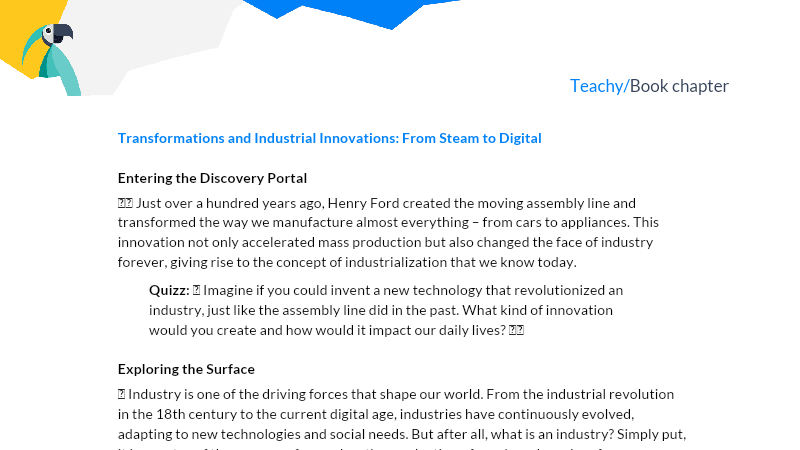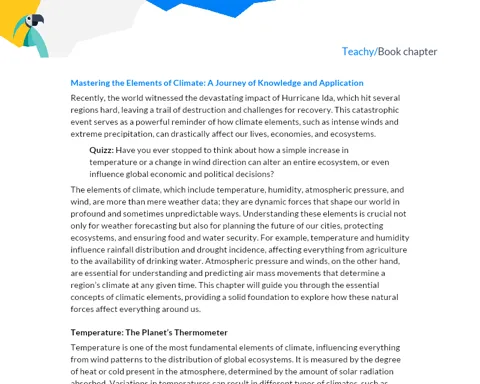Housing and Everyday Objects: Techniques and Sustainability
Chapter Title
Systematization
In this chapter, you will learn about different types of housing and everyday objects, exploring the techniques and materials used in their production. We will compare how these items vary in different social and cultural contexts and understand the importance of sustainable techniques and materials. You will also participate in practical activities that will help solidify the knowledge acquired and develop relevant skills for the real world.
Objectives
The objectives of this chapter are: To describe different types of housing and everyday objects; To compare techniques and materials used in the production of housing and objects; To promote critical observation of the surrounding environment; To awaken interest in the manufacturing and construction processes.
Introduction
From the houses we live in to the toys we play with, the objects of our everyday life surround us and influence our lives in various ways. Each of these items has a story and a manufacturing technique behind it, which varies according to the material used and the purpose of the object. Understanding these differences is essential to appreciate diversity and recognize the importance of production and construction processes in our daily lives. Furthermore, by learning about the materials and techniques used, we can develop a more critical and conscious perspective on the choices we make regarding consumption and sustainability.
In the job market, professionals like architects, engineers, and industrial designers use knowledge of materials and production techniques to create innovative and sustainable solutions. For example, some houses are built entirely with recycled materials, while certain toys are designed by engineers specialized in ergonomics to ensure the safety of children. Professions such as carpenters and seamstresses apply practical skills daily to produce objects that are part of our everyday lives, demonstrating how theoretical knowledge translates into useful and applicable practical skills.
Through this chapter, you will be encouraged to observe and reflect on the objects around you, considering the materials and techniques involved in their production. Additionally, we will explore the importance of sustainability in choosing these materials and how it can positively impact the environment. At the end of the chapter, you will have participated in practical activities that reinforce these concepts, preparing you to apply this knowledge critically and consciously in real-world situations.
Exploring the Theme
In this chapter, we will explore in detail the different types of housing and everyday objects, focusing on the techniques and materials used in their production. Through a practical approach, you will learn to describe and compare these items, developing critical and observational skills essential for understanding cultural diversity and the importance of sustainability. Throughout this development, you will participate in activities ranging from critical observation to practical construction, applying the theoretical concepts learned.
Let's start by understanding the different types of housing. Brick houses, stilt houses, cabins, and igloos are examples of dwellings that vary according to the environment and available resources. Each type of housing uses different materials and construction techniques, adapting to the climate and cultural conditions of the region. For example, masonry is common in urban areas and uses bricks and concrete, while stilt houses are constructed in flooded areas, elevating the house on wooden stakes.
In addition to housing, everyday objects like toys, clothing, and furnishings are also produced using a variety of materials. Toys can be made of plastic, wood, or fabric, each with its own production techniques and objectives. Clothing is made from fabrics such as cotton, polyester, and wool, and furniture can be produced from wood, metal, or recyclable materials.
Understanding these production processes is essential not only to appreciate the diversity of techniques and materials but also to develop a critical awareness of sustainability. The choice of recyclable materials and the application of sustainable techniques can reduce environmental impact and promote more responsible use of natural resources. Throughout this chapter, you will be encouraged to reflect on these issues and apply the knowledge gained in practical activities.
Theoretical Foundations
The theoretical foundations of this chapter are based on understanding the different types of housing and everyday objects, as well as the techniques and materials used in their production. We will explore the concepts of masonry, stilt houses, cabins, and igloos, analyzing how each of these types of housing adapts to the environment and the cultural and climatic needs of the region.
Masonry is a construction technique that uses bricks, concrete blocks, and cement to create solid and durable structures. It is widely used in urban areas due to its strength and thermal and acoustic insulation capacity. Stilt houses, on the other hand, are elevated dwellings on stakes, common in flooded regions or areas prone to flooding. This technique allows the house to be above water level, protecting residents from floods.
Cabins are simple structures, usually made of wood or natural materials available in the region. They are common in rural and tribal areas where resources are limited. Igloos, in contrast, are shelters made of snow blocks, used by Inuit peoples in arctic regions. Compacted snow acts as thermal insulation, keeping the inside of the igloo relatively warm.
In addition to housing, everyday objects like toys, clothing, and furnishings also have important theoretical foundations. The production of toys involves choosing safe and durable materials such as plastic, wood, and fabric. Clothing is made from different types of fabrics, each with its own characteristics and advantages. Furniture, in turn, can be produced from a variety of materials, including wood, metal, and recyclable materials.
These theoretical foundations are essential for understanding how different types of housing and everyday objects are produced and how they can be adapted to promote sustainability and cultural diversity.
Definitions and Concepts
Definitions and Concepts
Types of Housing
Masonry: A construction technique that uses bricks, concrete blocks, and cement. It is common in urban areas and offers good strength and thermal and acoustic insulation.
Stilt Houses: Elevated dwellings on stakes, common in flooded regions. They protect residents from floods and are generally made of wood.
Cabins: Simple structures made of wood or natural materials available locally. They are found in rural and tribal areas.
Igloos: Shelters made of snow blocks, used by Inuit peoples in arctic regions. Compacted snow functions as thermal insulation.
Everyday Objects
Toys: Can be made of plastic, wood, or fabric. They should be safe and durable, designed to ensure children's safety.
Clothing: Made from fabrics such as cotton, polyester, and wool. Each fabric has its specific characteristics, such as comfort and durability.
Furnishings: Produced from wood, metal, or recyclable materials. They can vary in design and function, adapting to the users' needs.
Basic Principles
Sustainability: The choice of materials and techniques that minimize environmental impact, promoting responsible use of natural resources.
Cultural Diversity: Valuing the different techniques and materials used in different social and cultural contexts.
Safety and Functionality: Ensuring that everyday objects are safe and functional, meeting the users' needs.
Practical Applications
Practical Applications
The practical application of the theoretical concepts addressed in this chapter involves critical observation and the construction of objects using sustainable materials. We will explore how this knowledge can be applied in different contexts and how you can use tools and resources to deepen your understanding.
Application Examples
Building Mini Sustainable Houses: Using recyclable materials such as cardboard boxes, plastic bottles, and toilet paper rolls, you can construct mini houses that exemplify the concepts of sustainability and diversity of construction techniques.
Toy Production: Create toys using safe and durable materials, such as wood and fabric, applying knowledge about ergonomics and child safety.
Clothing Design: Use different types of fabrics to make clothing pieces, exploring the characteristics and advantages of each material.
Furniture Design: Design furniture from recyclable materials, considering functionality and environmental impact.
Tools and Resources
Blunt Scissors: For safely cutting materials.
Glue and Adhesive Tape: To join different materials when building objects.
Markers and Drawing Paper: To decorate and personalize the constructed objects.
Recyclable Materials: Cardboard boxes, plastic bottles, toilet paper rolls, and bottle caps.
Assessment Exercises
Describe two different types of housing you know and the materials used in their construction.
Compare the construction techniques of a masonry house and a stilt house, highlighting the advantages and disadvantages of each.
Explain how the choice of recyclable materials can impact sustainability in the production of everyday objects.
Conclusion
In this chapter, we explored in detail the different types of housing and everyday objects, focusing on the techniques and materials used in their production. We learned to describe and compare these items, developing critical and observational skills essential for understanding cultural diversity and the importance of sustainability. The practical activities carried out helped reinforce the theoretical knowledge and apply these concepts in a concrete and meaningful way.
As next steps, it is important that you continue observing the objects around you, reflecting on the materials and techniques used in their production. Prepare for the lecture by reviewing the concepts discussed and actively participating in classroom discussions. Deepen your understanding of the importance of sustainability and cultural diversity in the production of housing and everyday objects, and be ready to share your observations and insights with your peers.
Going Beyond- Describe how different types of housing adapt to the climatic and cultural conditions of a specific region.
-
Explain the importance of choosing sustainable materials in the construction of housing and in the production of everyday objects.
-
Compare the production techniques of plastic and wooden toys, highlighting aspects of safety and durability.
-
Discuss how cultural diversity influences the techniques and materials used in the production of clothing and furnishings.
-
Analyze the environmental impacts of using recyclable materials in construction and in the design of everyday objects.
Summary- Understanding the different types of housing (masonry, stilt houses, cabins, igloos) and the materials used in their construction.
-
Analysis of the production techniques of everyday objects (toys, clothing, furnishings) and the choice of materials.
-
Importance of sustainability in choosing materials and production techniques.
-
Valuing cultural diversity and different social contexts in the production of housing and objects.



